Palintonicity: an unknown principle that forms one of the key elements of proper physical yoga practice.
The funny thing is, yoga practitioners may already be using it and not even know it.
Literally, “stretched back and forth” or more poetically translated as “unity in opposition”, it is the act of finding length in two directions equally and it’s a term coined by early Rolfers.
Palintonicity is key to achieve the natural support our body is capable of.
Palintonicity works for two reasons. First, it activates the core muscles (also known as the intrinsic muscles) that help to support the spine and other parts of the body from a truly deep level. The second reason is that it works with another, more subtle part of the nervous system that moves the body in a more supported, graceful manner.
One of the easiest ways to experience palintonicity is on our hands and knees, or the starting point of cat-and-cow pose in which we hold a neutral spine.
When we are not sure “where” a neutral spine is, it may be difficult to get there, even in this simple posture. Aren’t spines always neutral? Well, no. Gravity affects the spine disproportionately when we’re in this position, due to its natural curvature, especially in the lower part. Also called the lumbar spine, this section will naturally tilt towards the ground when on hands and knees.
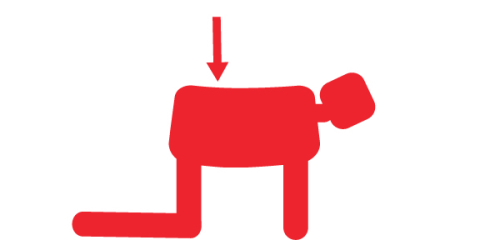
This will give the appearance of the belly hanging down and the lower back collapsing.
No two spines are the same, so attempting to lift our spine to a “neutral” position by looking at someone else probably won’t help to find our neutral spine. Instead of struggling to hold the spine in a neutral position by lifting the lower back for some unknown amount, we should try the following.
First, we level our head level with the spine, meaning the eyes will be looking down towards the ground, either directly below the head or a few inches in front of the hands. Then we focus on the topmost point on our head (the crown chakra). We begin to stretch forward as if we were trying to touch the wall in front of us with the top of our head. Then we focus on the tailbone and begin to stretch it in the opposite direction, as if we were trying to touch the wall behind us with.
As we stretch both ends as much as possible, we imagine a line extending out in both directions from our head and from our tail. The spine lifts naturally and finds a neutral position. With magical arrows showing the directions, it would look like this:
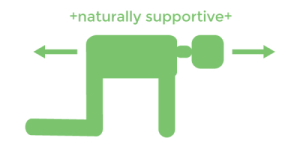
This is our true anatomically neutral spine position.
Now we can apply the same principle to different positions, progressing to sitting first. We press the backside down into the floor, chair or bench and reach the head up towards the sky. In this position, it is easiest to look towards the horizon. We should feel the core activate slightly. If not, putting a hand on the belly may help. There is no need to tuck the belly in, five to 10 percent of our maximum contraction should be enough. The key to this one is to focus on pressing the backside down into the bench or chair.
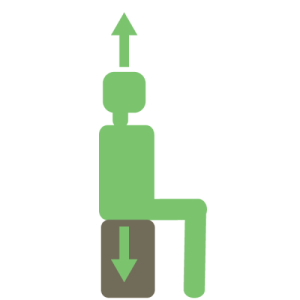
As we press down, our head naturally starts to lift up.
So far we’ve been talking just about the spine, but we can apply this to different positions and use the same principle on different body parts, the arms for example.
We stretch the arms out and reach forward as far as we possibly can. How does that feel? Probably not so good. Now, we focus on our shoulder blades in the back and our fingertips in front of us. Without straining, we stretch our fingers forward and imagine we are able to touch the wall in front of us. At the same time, we press our shoulder blades back and imagine they reach the wall behind us.

The stretch in our arms feel very different from when we simply strain to reach forward.
We can do this in just about any position. We can challenge ourselves to try it with different positions and different asanas, such as Warrior III.
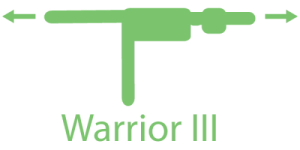
As we balance on one leg, we reach out through the top of the head and the bottom of your lifted foot.
Or we can try it in Paschimattanasana (forward fold). We press our sitting bones back while stretching the bottom of our feet forward. At the same time, we stretch the top of our head up while we press our tailbone down in the opposite direction.
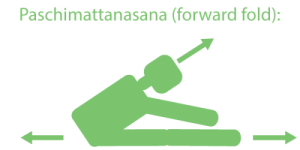
Palintonicity can and perhaps should be applied in all asanas, so I urge everybody to explore this principle to improve their yoga practice!
Love elephant and want to go steady?
Sign up for our (curated) daily and weekly newsletters!
Apprentice Editor: Yaisa Nio / Editor: Renée Picard
Photo/Images: Wikimedia Commons, Author’s own
Ready to join?
Hey, thanks so much for reading! Elephant offers 1 article every month for free.
If you want more, grab a subscription for unlimited reads for $5/year (normally, it's $108/year, and the discount ends soon).
And clearly you appreciate mindfulness with a sense of humor and integrity! Why not join the Elephant community, become an Elephriend?
Your investment will help Elephant Journal invest in our editors and writers who promote your values to create the change you want to see in your world!
Already have an account? Log in.
Ready to join?
Hey, thanks so much for reading! Elephant offers 1 article every month for free.
If you want more, grab a subscription for unlimited reads for $5/year (normally, it's $108/year, and the discount ends soon).
And clearly you appreciate mindfulness with a sense of humor and integrity! Why not join the Elephant community, become an Elephriend?
Your investment will help Elephant Journal invest in our editors and writers who promote your values to create the change you want to see in your world!
Already have an account? Log in.
 Share on bsky
Share on bsky






Read 1 comment and reply